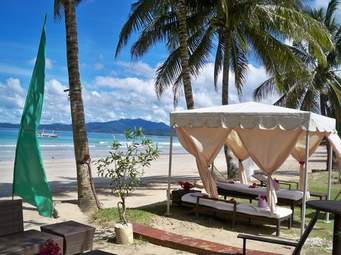WELCOM TO SABANG
Sabang's charm offers the beauty of a beautiful coastline, nan blue and clean sea water and green trees. However, not only marine tourism can be found in Sabang. There are mountains, lakes, beaches, sea, as well as the forest is still natural and awake waiting to be visited. Not to mention your interaction with the local community will provide a memorable experience.
Sabang is a beautiful small town with a hilly land structure so locals call the city of Sabang with two names namely the city down and the city top.
Sabang consists of five large and small islands, namely Weh Island as the largest island, Rubiah Island, Klah Island, Seulako Island, and Rondo Island. The population is about 26,000 inhabitants. Sabang is divided into two sub-districts and 72 villages. Topography includes lowland, bumpy, hilly and mountainous terrain, and rocks along the coast.
The Sabang border to the east is the Malacca Strait, west to the Indonesian Ocean, north to the Malacca Strait, and the south by the Indonesian Ocean.
At the time of the Kingdom of Aceh, Weh Island area itself is a place of expulsion or moved "geupeuweh" for someone who is subject to heavy penalties from the kingdom. The name geupeuweh is then attached to the name of this island and along with the time then the pronunciation abbreviates to Weh and is defined as a separate island..jpg)
The word "sabang" comes from the Acehnese word "saban" which means equal rights and position in all things. This is attributed to the existence of Sabang, which was once visited by many outsiders to open the garden (seuneubôk) or other business.
The arrivals come from different regions with different cultures, both attitudes, values, and customs. Gradually assimilation occurs where the various differences eventually fade and their positions become the same. The term saban has long been attached to Weh Island which then slowly changes its mention to "Sabang".
Sabang is the only area of the Kingdom of Aceh that can be fully controlled by the Government of the Netherlands East
Indies. Since 1881, Sabang is designated as a natural harbor called Kolen Station.
The Dutch East Indies government then built various facilities and infrastructure. Especially after 1887 when Sabang Haven obtained the authority to build a port supporting facility.
In 1895, Sabang became a Vrij Haven free port area run by Sabang Maatschaappij (Maatschaappij Zeehaven en Kolen Station). At that time the name Sabang increasingly popular in the archipelago and internationally as a port of international trade circulation.
World War II had destroyed Sabang until 1942 occupied Japan and made it the maritime base of the Japanese Navy. Unfinished repairs due to war, the physical damage of the island is getting worse after the Allied Troops bombard it so that makes Sabang was closed.
.jpg)
It was only after Sabang's independence period was established as the center of Navy Defense of the Republic of Indonesia (RIS) and all assets of Sabang Maatschaappij Port were purchased by the Government of Indonesia.
In 1965 formed the government of Sabang Municipality and initiated efforts to re-open Sabang Port Free and Free Trade Area. This new effort was officially confirmed in 2000.
After the peace agreement between the Government of Indonesia and GAM on August 15, 2005, Sabang again crowded. Sabang Free Port re-opened to speed up the economic development of Aceh through economic relations with abroad. In addition, a variety of maritime destinations and cultural uniqueness of Aceh was re-introduced to tourists coming to enjoy the charm of the island's most western island in Indonesia.